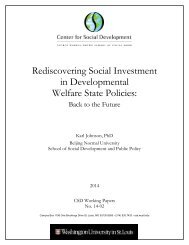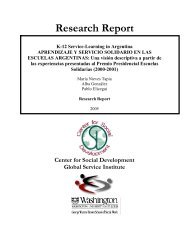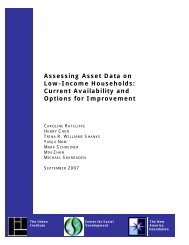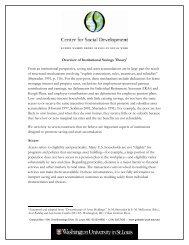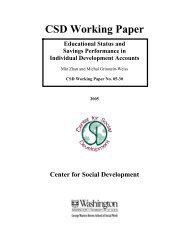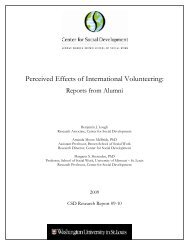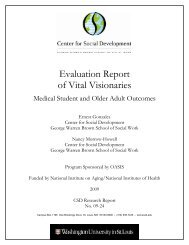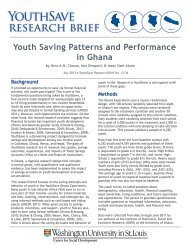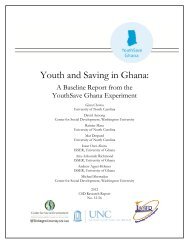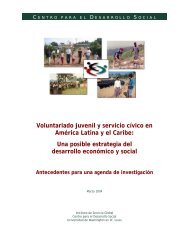Exploring and Assessing Intercultural Competence - Center for ...
Exploring and Assessing Intercultural Competence - Center for ...
Exploring and Assessing Intercultural Competence - Center for ...
Create successful ePaper yourself
Turn your PDF publications into a flip-book with our unique Google optimized e-Paper software.
Table 11: Percentage Responses <strong>for</strong> Spanish Language Ability<br />
<strong>Exploring</strong> <strong>and</strong> <strong>Assessing</strong> <strong>Intercultural</strong> <strong>Competence</strong><br />
Spanish Language Ability % Beginning % End<br />
No ability at all. 46.4 0.0<br />
Unable to function in spoken language. 28.6 0.0<br />
Able to communicate in a limited way. 14.3 0.0<br />
Able to satisfy immediate needs. 10.7 0.0<br />
Able to satisfy basic survival needs. 25.0 0.0<br />
Able to satisfy some survival needs. 14.3 3.6<br />
Able to satisfy most survival needs & limited social dem<strong>and</strong>s. 7.1 3.6<br />
Able to satisfy routine social & limited work requirements. 10.7 14.3<br />
Able to communicate on some concrete topics. 14.3 42.9<br />
Able to speak with sufficient structural accuracy. 7.1 32.1<br />
Able to speak with sufficient structural accuracy & discuss professional areass 3.6 21.4<br />
Able to speak Spanish fluently on all levels. 0.0 14.3<br />
Speaking proficiency sometimes equivalent to an educated native speaker. 0.0 17.9<br />
Proficiency equivalent to an educated native speaker 0.0 1.0<br />
Figure 3: Improvement in Spanish Language Ability<br />
Percentages<br />
50<br />
40<br />
30<br />
20<br />
10<br />
0<br />
Improvement in Spanish Language Ability<br />
1 2 3 4 5 6 7 8 9 10 11 12 13 14<br />
Spanish Language Ability Items<br />
10. Qualitative Analysis <strong>and</strong> Discussion<br />
<strong>Center</strong> <strong>for</strong> Social Development<br />
Washington University in St. Louis<br />
% Beginning<br />
% End<br />
Unlike statistical analysis which is concerned with numerical size, qualitative analysis was able to<br />
use data obtained from all groups of program participants (alumni, volunteers, <strong>and</strong> mentors),<br />
conducted in two ways (survey <strong>and</strong> interviews), at various points in time (beginning <strong>and</strong> end of<br />
the program), <strong>and</strong> from etic <strong>and</strong> emic perspectives. To keep these two perspectives distinct, the<br />
analysis below is in three parts: Alumni <strong>and</strong> Volunteers, Mentors (about volunteers), <strong>and</strong> Mentors<br />
(about themselves). Be<strong>for</strong>e arriving at the composite views presented in this section, however,<br />
data were first clustered <strong>and</strong> analyzed separately by sub-sets to provide in<strong>for</strong>mation about each<br />
nationality group separately. Data were then examined <strong>for</strong> insights regarding the 10 assertions<br />
identified in our original research proposal <strong>and</strong> listed again below in the sections that follow.<br />
25



